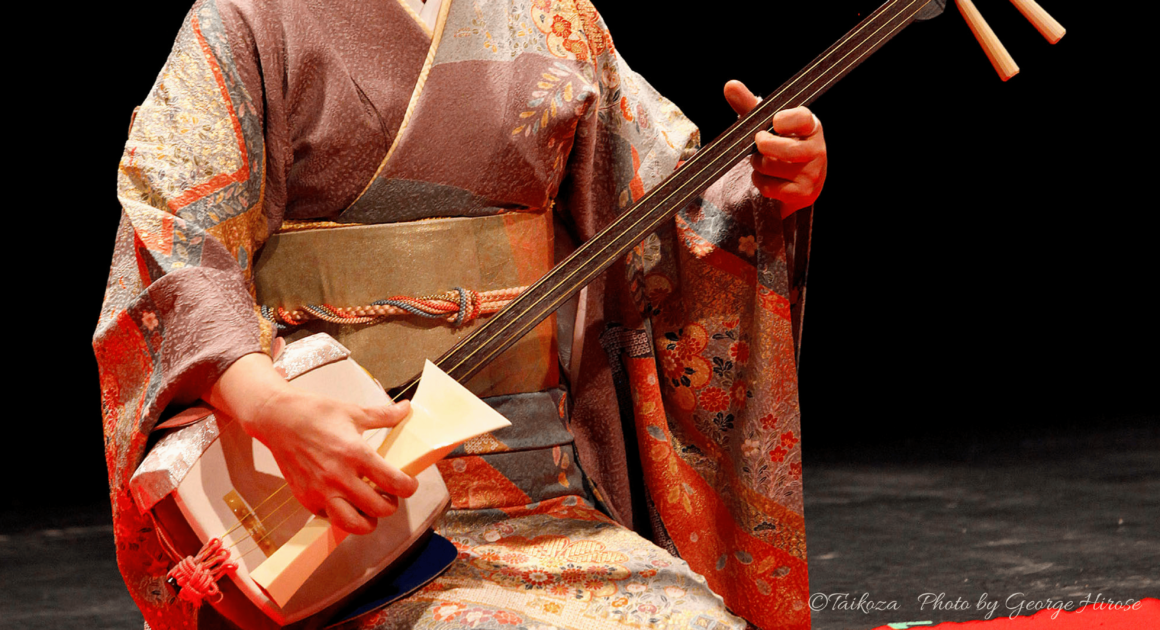About Shamisen

Shamisen is Japan’s traditional 3-string plucked instrument
Relatively a new instrument, brought from China to Japan during the 16th century, the Shamisen is one of Japan’s most popular traditional string instruments. A variety of shamisen instruments are found in the performing arts genre, both as a solo and accompaniment instrument, which underscores why this instrument has long been loved and well embraced by the Japanese people.
History
During the 14th to the 15th century, the Chinese introduced the instrument called sanxian to the Ryukyū Kingdom (current day Okinawa Prefecture.) Over time, this instrument would transform into something called “sanshin” (三線), which was introduced to the main island of Japan during the 16th century.
Within the traditional string instruments, the unique accessibility of this instrument made it widely popular and as a result created many musical theatrical performing outlets: “jiuta” (地歌), “joruri” (浄瑠璃), “kabuki” (歌舞伎). In addition, the shamisen is widely used in Japanese regional folk songs, and festivals, supporting various types of music from which the shamisen instrument evolved.
*For further information, please refer to the “Types of Shamisen.”
Instrument
- Construction
The long neck of the instrument is referred to as “sao” (棹): “hosozao” (細棹) / thin neck, “chuzao” (中棹) / medium neck, “futozao” (太棹) / wide neck. There are 2 types of sao necks, one is comprised of 3 sections and the other is a single part neck. The assembly of the 3-part neck speaks to the extremely high skill of the shamisen master craftsman, seamlessly making it look like a single neck.
The “dō” (胴), is the body of instrument traditionally made by using cat or dog skin, though, in recent years, artificial and synthetic materials have been utilized to this end.
The “koma” (駒), is the bridge, placed onto the dō, where it serves to support the strings. Interestingly enough, the koma is made out of various materials ranging from cow bone, ivory, tortoiseshell, bamboo or plastic.
There are 3 strings or “gen” / “ito” (絃). The string materials are made out of silk, nylon or tetron. The varying thickness of the strings is a notable distinction, as the thickness is more or less contingent upon the type of shamisen instrument.
The “bachi” (撥), is the plectrum also made out of ivory, tortoiseshell or plastic. The size of the bachi depends on the type of shamisen and the music.
“Sawari” (さわり), is a unique timbre of the instrument, comprised of overtones that create a “buzzing” sound. It is vital to note that the 1st lowest string is slightly lowered creating this buzzing sound. The sawari produces many overtones and suspends the sounds – resulting in such distinct effects. The sawari is one of the shamisen’s characteristic noise sounds of the instrument.
- Tuning
The samisen uses specific tuning for its compositions. At times there are tuning changes in the middle of the song. The “itomaki” (糸巻き) / the tuning pegs are tightened or loosened to change the tuning of the instrument.
- Technique
While the right hand is used for the plectrum to strum the strings, the plectrum is also used as a percussive technique. The right hand also uses pizzicato technique without the use of the plectrum.
As a fretless instrument, a high level of skill is required to obtain the specific pitch of the notes.
Form and Varieties of Shamisen
The varying forms of shamisen are differentiated by the thickness of the neck. “Hosozao” (細棹) / thin neck, “chuzao” (中棹) / medium neck, and “futozao” (太棹) / wide neck. Specific types of shamisen are utilized to perform for the specific varieties of shamisen music. For instance, “gidayu-bushi” (義太夫節) and Tsugaru folk songs use both the futozao / wide neck shamisen, however, there are distinctive differences in shape.
The main features of the shamisen: “koma” (駒), “bachi” (撥) and “gen / ito” (絃), are also specific to the different styles of shamisen. Therefore, it is said that there are dozens of types of shamisen, all originating from the “sanshin” (三線).
Below are the major types of shamisens:
Hosozao(細棹)/ Thin neck
- Nagauta shamisen(長唄三味線)
During the 17th century, “kabuki” (歌舞伎) theater and dance rose to popularity.
“Nagauta” (長唄) is the genre of shamisen accompaniment music developed for kabuki. The instrument used became to be known as “nagauta Shamisen” (長唄三味線). Since nagauta has developed as kabuki theater music, there are many flashy, rhythmic songs, which the narrow shamisen and small body allow for bright and high timbre. Depending on the song, the nagauta shamisen is also performed as an ensemble accompanied by the fue-flute and percussion instruments called “ohayashi” (お囃子).
Chuzao(中棹)/ Medium neck
- Jiuta shamisen(地歌三味線)
The “jiuta” (地歌) is a genre of shamisen music developed by the “tōdō” (当道), during the 17th century, a guild for blind men. The jiuta refers to the song of the Kansai region (ie. Osaka, Kyoto) from the Edo period. The performer sings while accompanying himself on the “jiuta shamisen” (地歌三味線). “Ikuta Kengyo” (生田検校) added the koto to the jiuta, therefore, it is normal for koto performers to play not only koto but also the jiuta shamisen. Depending on the koto school, sometimes the performance of the jiuta shamisen is a required examination when qualifying for the esteemed distinction of koto master.
Futozao(太棹)/ Wide neck
- Gidayu shamisen(義太夫三味線)
The “gidayu shamisen” (義太夫三味線) is an instrument used for “gidayu-bushi” (義太夫節). During the 17th century, “Takemoto Gidayu” (竹本義太夫), the master chanter from the traditional Japanese theater created gidayu-bushi, music for “ningyō jōruri” (人形浄瑠璃). Ningyo joruri is also known as “bunraku” (文楽), a form of traditional Japanese theater featuring puppeteers, chanters, and shamisen performers. Since the gidayu shamisen was developed for the theater to accompany the narrator, it produces a lower register sound, echoing the low and thick sound of the narrator’s chant. This is the largest of the shamisen instrument with bridges embedded with lead, along with the use of a larger plectrum.
- Tsugaru shamisen(津軽三味線)
“Tsugaru shamisen” (津軽三味線) originated from the Tsugaru region (current day Aomori Prefecture), an instrument originally created for the accompaniment of Tsugaru folk songs during the 19th century. It has evolved not only as an accompaniment but also as a solo instrument. The tsugaru shamisen plectrum has a fast action. The musician strikes the instrument body creating a percussive quality fueling a dynamic and powerful performance. The tsugaru shamisen often uses the futozao / wide neck, however, there are also chuzao / medium neck and hosozao / thin neck instruments. This instrument is widely performed in various music genres such as rock, jazz, and pop.
Sanshin(三線)
“Sanshin” (三線) is a traditional instrument of Okinawa. During the 14th to the 15th century, the Chinese introduced the instrument called sanxian to the Ryukyū Kingdom (current day Okinawa Prefecture). This instrument ultimately developed into something called sanshin. This banjo-like instrument is smaller than the shamisen, consisting of python snakeskin stretched onto the torso of the body. The plectrum is made out of water buffalo horn and it can be also played with guitar picks and fingers.
Resources
Discover additional information about the Shamisen below



